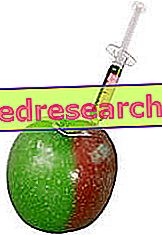- Low density lipoprotein (LDL) is called bad cholesterol.
- High density lipoproteins (HDL) are called good cholesterol.
A lipoprotein is a particle characterized by a lipid heart wrapped in a protein shell. Within the bloodstream, all fats, including cholesterol, are enclosed in lipoproteins. Only in this way can they reach the various fabrics undisturbed.

Apparently this nomenclature makes no sense given that, as we saw in the previous article, LDLs are essential for distributing cholesterol to cells. To function properly, our body needs a constant supply of cholesterol, trouble if it is missing!
However, excess LDL can undergo structural changes, caused by oxidizing agents such as free radicals, and infiltrate the walls of large arterial vessels. This produces a triple disadvantage:
- mechanical obstacle to the blood flow: the oxidized LDLs are deposited on the wall of the large arterial vessels after being incorporated by macrophages. The muscle cells that make up the vessel wall also begin to multiply in these sites. A plaque is thus formed, called atherosclerotic, which tends to grow over time. In this way the lumen of the vessel is progressively reduced and the blood flows with greater difficulty.
- Reduced elasticity of the walls of the arteries: the elasticity of the arteries is very important, because together with the propulsive action of the heart pump, it helps to push the blood downstream. Since atherosclerotic plaques decrease arterial elasticity, their presence translates into a further obstacle to circulation.
- Thrombus formation: some parts of the plaque can become detached, becoming true stray mines that, when they go to fill certain capillaries, prevent the arrival of blood to the affected tissue.
- See also: atherosclerosis; good eicosanoids and bad eicosanoids.
To prevent these dangerous situations it is very important to consume a wide variety of antioxidant foods. Some vitamins, for example, have the ability to counteract the harmful activity of free radicals.
So the LDLs, called bad cholesterol, are such only when they are in excess and when they are oxidized. In normal situations, they are indispensable for the good health of the body.
HDL, on the other hand, is called good cholesterol, since it acts as a veritable scavenger capable of collecting excess cholesterol and transporting it to the liver. From here this compound will be incorporated into the bile salts, poured into the intestine and partly expelled with feces.
LDLs may be present in excess due to high cholesterol consumption with the diet. However very often it is a secondary phenomenon, since cholesterol circulating in the blood has a dual origin:
- exogenous: derives from foods of animal origin (15% -20%)
- endogenous: it is synthesized by all the cells of the body (80%)
Almost always the cause of an excessive concentration of LDL in the blood lies in the increased endogenous production of cholesterol.
Normally there is a regulation so that, if there are many LDL in circulation, the endogenous synthesis is strongly limited. However, there are various conditions that distort this regulatory mechanism, decreasing the sensitivity of cells to the presence of LDL. The less cholesterol is brought in, the less cholesterol arrives and the more LDLs are released into the circulation.
In fact, a cell has two possibilities: to obtain cholesterol from LDL or to synthesize it in complete autonomy. Normally there is a regulation so that first of all the cells use LDL cholesterol and only in case of lack of these lipoproteins do they start the endogenous synthesis.
If the receptor that detects the presence of LDL is malfunctioning the cell becomes insensitive to LDL and, despite the abundance of circulating cholesterol, it continues to produce more. Thus we enter a vicious circle that increases significantly in risk of atherosclerosis and cardiovascular diseases in general.
When performing blood tests, various parameters are evaluated, first of all total cholesterol. This figure expresses the total amount of cholesterol contained in the various lipoproteins. A value lower than 200 mg / 100 ml of blood is considered correct.
Until recently, doctors were content to detect this value, but today it is also necessary to evaluate the amount of good cholesterol or HDL. In general, this parameter must not be less than 40 mg / 100 ml.
More than total cholesterol, it is therefore important to evaluate the relationship between this data and the good or HDL fraction. A condition in which the total cholesterol is slightly higher than the norm and in which the HDL fraction is also higher, compared to the opposite case, is more favorable to health.
Today, effective strategies are being studied to increase good cholesterol levels and decrease bad cholesterol levels. Physical activity, for example, is able to increase the concentration of HDL. A similar argument can be made for estrogens which, until menopause, provide women with a lower risk of cardiovascular diseases than men. It also seems that the populations in which the diet is particularly rich in phytoestrogens (natural substances contained in plant foods such as soy) enjoy a lower cardiovascular risk than those in the West. The dietary aspect is indeed important, for this reason it has been extensively treated in a special article: diet and cholesterol.
REFERENCE VALUES FOR HEALTHY POPULATION:
* A total cholesterol: less than 200 mg / dl
* B good cholesterol (HDL): greater than 40 mg / dl
* C triglyceridemia: between 50 and 170 mg / dl
* D bad cholesterol (LDL): less than 160 mg / dl
* And risk index (total cholesterol / HDL): less than 5 if man or 4.5 if woman



